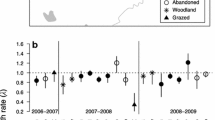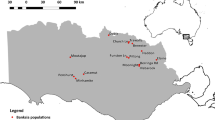Abstract
The knowledge about determinants of species survival is fundamental in conservation. Beyond determinants affecting local population survival, metapopulation theory emphasises the importance of processes operating on larger spatial scales (e.g. dispersal). We studied dispersal capacity and requirements for seedling recruitment of the threatened fen grassland species Trollius europaeus in order to assess the species’ ability to persist under the current land use conditions in the study region, north-east Germany. We used a seed sowing experiment and simulated endozoochorous and hydrochorous dispersal in a field and a laboratory experiment. Germination success reflected the experimental reduction of vegetation complexity, but the germination and recruitment rate was overall low. Survival was followed 2008–2011 and was best on plots with an intact moss layer. Mollusc exclusion displayed no significant effect. Endozoochorous dispersal is possible, however, in only minor quantities. Hydrochorous dispersal is very limited and negligible for connecting distant patches. We found evidence for microsite limitation, remnant population dynamics and the existence of unoccupied but suitable habitat patches available for colonization in our study region. However, (re-)colonization events are probably very rare due to dispersal limitation stressing the need for artificial seed transfer within the scope of restoration projects. Therefore, large quantities of seed material should be used in combination with mowing and thorough litter removal but leaving the moss layer intact. Management should be continued for longer than just the introduction year. Our study contributes to the understanding of species dynamics in fragmented landscapes. In particular, it contributes to the conservation of T. europaeus as an indicator of species-rich fen meadows in its Central European range.



Similar content being viewed by others
References
Bates D, Maechler M, Bolker B (2011) lme4: Linear mixed-effects models using S4 classes. R package version 0.999375-39
Bonn S, Poschlod P (1998) Ausbreitungsbiologie der Pflanzen Mitteleuropas. Quelle & Meyer, Wiesbaden
Bruelheide H, Scheidel U (1999) Slug herbivory as a limiting factor for the geographical range of Arnica montana. J Ecol 87:839–848
Bullock JM (2000) Gaps and seedling colonization. In: Fenner M (ed) Seeds: the ecology of regeneration in plant communities, 2nd edn. CAB International, Wallingford, pp 375–395
Clark CJ, Poulsen JR, Levey DJ, Osenberg CW (2007) Are plant populations seed limited? A critique and meta-analysis of seed addition experiments. Am Nat 170:128–142
Danvind M, Nilsson C (1997) Seed floating ability and distribution of alpine plants along a northern Swedish river. J Veg Sci 8:271–276
Diemer M, Oetiker K, Billeter R (2001) Abandonment alters community composition and canopy structure of Swiss calcareous fens. Appl Veg Sci 4:237–246
Dupré C, Ehrlén J (2002) Habitat configuration, species traits and plant distributions. J Ecol 90:796–805
During HJ, van Tooren BF (1990) Bryophyte interactions with other plants. Bot J Linn Soc 104:79–98
Eckstein RL, Donath TW (2005) Interactions between litter and water availability affect seedling emergence in four familial pairs of floodplain species. J Ecol 93:807–816
Ehrlén J, Eriksson O (2003) Large-scale spatial dynamics of plants: a response to Freckleton & Watkinson. J Ecol 91:316–320
Eriksson O (1996) Regional dynamics of plants: a review of evidence for remnant, source-sink and metapopulations. Oikos 77:248–258
Eriksson O (2002) Ontogenetic niche shifts and their implications for recruitment in three clonal Vaccinium shrubs: Vaccinium myrtillus, Vaccinium vitis-idaea, and Vaccinium oxycoccos. Can J Bot 80:635–641
Eriksson O, Ehrlén J (1992) Seed and microsite limitation of recruitment in plant populations. Oecologia 91:360–364
Freckleton RP, Watkinson AR (2002) Large-scale spatial dynamics of plants: metapopulations, regional ensembles and patchy populations. J Ecol 90:419–434
Grime JP, Hunt R (1975) Relative growth-rate: its range and adaptive significance in a local flora. J Ecol 63:393–422
Grubb PJ (1977) The maintenance of species-richness in plant communities: the importance of the regeneration niche. Biol Rev 52:107–145
Hanski I, Gilpin M (1997) Metapopulation biology. Academic Press, San Diego
Harper JL (1977) Population biology of plants. Academic Press, London
Harrison S (1991) Local extinction in a metapopulation context: an empirical evaluation. Biol J Linn Soc 42:73–88
Higgins SI, Nathan R, Cain ML (2003) Are long-distance dispersal events in plants usually caused by nonstandard means of dispersal? Ecology 84:1945–1956
Hitchmough JD (2003) Effects of sward height, gap size, and slug grazing on emergence and establishment of Trollius europaeus (globeflower). Rest Ecol 11:20–28
Hitchmough JD, Gough J, Corr B (2000) Germination and dormancy in a wild collected ecotype of Trollius europaeus. Seed Sci Technol 28:549–558
Hoffmann G (1991) VDLUFA—Methodenbuch. Die Untersuchung von Böden. VDLUFA, Darmstadt
Husband BC, Barrett SCH (1996) A metapopulation perspective in plant population biology. J Ecol 84:461–469
Jaeger N, Després L (1998) Obligate mutualism between Trollius europaeus and its seed-parasite pollinators Chiastocheta flies in the Alps. CR Acad Sci III-Vie 321:789–796
Jensen K, Schrautzer J (1999) Consequences of abandonment for a regional fen flora and mechanisms of successional change. Appl Veg Sci 2:79–88
Klimkowska A, van Diggelen R, Bakker JP, Grootjans AP (2007) Wet meadow restoration in Western Europe: a quantitative assessment of the effectiveness of several techniques. Biol Conserv 140:318–328
Knevel IC, Bekker RM, Kunzmann D, Stadler M, Thompson K (2005) The LEDA Traitbase collecting and measuring standards of life-history traits of the NW European flora. University of Groningen, Groningen
Lemke T (2011) The situation of Trollius europaeus L. (Ranunculaceae) in the north-east of Central Europe—history, current changes and conservation. Plant Divers Evol 129:219–228
Lemke T, Porembski S (2013) Variation in the reproductive performance of the Trollius-Chiastocheta mutualism at the edge of its range in north-east Germany. Oecologia 172:437–447
Linkola K (1935) Über die Dauer und Jahresklassenverhältnisse des Jugendstadiums bei einigen Wiesenstauden. Acta Forest Fenn 42:1–56
Middleton B, van Diggelen R, Jensen K (2006) Seed dispersal in fens. Appl Veg Sci 9:279–284
Milberg P (1994) Germination ecology of the polycarpic perennials Primula veris and Trollius europaeus. Ecography 17:3–8
Moore RP (1986) ISTA Handbuch für die Tetrazoliumuntersuchung. Internationale Vereinigung für Saatgutprüfung, Zürich
Münzbergová Z, Herben T (2004) Identification of suitable unoccupied habitats in metapopulation studies using co-occurrence of species. Oikos 105:408–414
Münzbergová Z, Herben T (2005) Seed, dispersal, microsite, habitat and recruitment limitation: identification of terms and concepts in studies of limitations. Oecologia 145:1–8
Otsus M, Zobel M (2004) Moisture condition and the presence of bryophytes determine fescue species abundance in a dry calcareous grassland. Oecologia 138:293–299
Ozinga WA, Römermann C, Bekker RM, Prinzing A, Tamis WLM, Schaminée JHJ, Hennekens SM, Thompson K, Poschlod P, Kleyer M, Bakker JP, van Groenendael JM (2009) Dispersal failure contributes to plant losses in NW Europe. Ecol Lett 12:66–74
Pellmyr O (1989) The cost of mutualism: interactions between Trollius europaeus and its pollinating parasites. Oecologia 78:53–59
Primack RB, Miao SL (1992) Dispersal can limit local plant distribution. Conserv Biol 6:513–519
R Development Core Team (2011) R: a language and environment for statistical computing. R Foundation for Statistical Computing, Vienna
Rasran L, Vogt K, Jensen K (2007) Effects of litter removal and mowing on germination and establishment of two fen-grassland species along a productivity gradient. Folia Geobot 42:271–288
Ridley HN (1930) The dispersal of plants throughout the world. L. Reeve, Ashford
Ruprecht E, Donath TW, Otte A, Eckstein RL (2008) Chemical effects of a dominant grass on seed germination of four familial pairs of dry grassland species. Seed Sci Res 18:239–248
Sorensen AE (1986) Seed dispersal by adhesion. Annu Rev Ecol Syst 17:443–463
Soulé ME, Wilcox BA (1980) Conservation biology: an evolutionary–ecological perspective. Sinauer Associates, Sunderland
Špačková I, Kotorová I, Lepš J (1998) Sensitivity of seedling recruitment to moss, litter and dominant removal in an oligotrophic wet meadow. Folia Geobot 33:17–30
Stampfli A, Zeiter M (1999) Plant species decline due to abandonment of meadows cannot easily be reversed by mowing. A case study from the southern Alps. J Veg Sci 10:151–164
Stubbe C (1997) Rehwild—Biologie, Ökologie, Bewirtschaftung, 4th edn. Parey, Berlin
Suding KN, Goldberg DE (1999) Variation in the effects of vegetation and litter on recruitment across productivity gradients. J Ecol 87:436–449
Tilman D, May RM, Lehman CL, Nowak MA (1994) Habitat destruction and the extinction debt. Nature 371:65–66
Tremlová K, Münzbergová Z (2007) Importance of species traits for species distribution in fragmented landscapes. Ecology 88:965–977
Turnbull LA, Crawley MJ, Rees M (2000) Are plant populations seed-limited? A review of seed sowing experiments. Oikos 88:225–238
van der Pijl L (1982) Principles of dispersal in higher plants, 3rd edn. Springer, Berlin
Xiong S, Nilsson C (1999) The effects of plant litter on vegetation: a meta-analysis. J Ecol 87:984–994
Young AG, Clark GM (2000) Genetics, demography and viability of fragmented populations. Cambridge University Press, Cambridge
Zuur AF, Ieno EN, Elphick CS (2010) A protocol for data exploration to avoid common statistical problems. Methods Ecol Evol 1:3–14
Acknowledgments
We would like to thank B. Eichler-Löbermann and G. Breuel (Agronomy, University of Rostock) for supporting the soil analysis, S. Adler (Rostock/Umeå) for help in statistical issues, H. Henker (Neukloster) and H.-D. Bringmann (Amt für Stadtgrün Rostock) for information about former and current land use practices and A. Schmidt (StALU Rostock) as well as the land owners for permission to work on the study sites. We sincerely thank the Rostock Zoological Garden for supporting the feeding experiments.
Author information
Authors and Affiliations
Corresponding author
Additional information
Communicated by Anne Bonis.
Electronic supplementary material
Below is the link to the electronic supplementary material.
Rights and permissions
About this article
Cite this article
Lemke, T., Janßen, A. & Porembski, S. Multiple limitations to the persistence of Trollius europaeus in a fragmented agricultural landscape in the context of metapopulation theory. Plant Ecol 216, 319–330 (2015). https://doi.org/10.1007/s11258-014-0439-3
Received:
Accepted:
Published:
Issue Date:
DOI: https://doi.org/10.1007/s11258-014-0439-3




